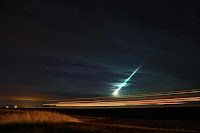Asteroid
2015 VZ2 passed by the Earth at a distance of 5 294 000 km (10.8 times
the average distance between the Earth and the Moon, or 3.54% of the
average distance between the Earth and the Sun), slightly after 2.50 am
GMT on Sunday 8 November 2015. There
was no danger of the asteroid hitting us, though had it done so it
would have presented a genuine threat. 2015 VZ2 has an estimated
equivalent diameter of 57-180 m (i.e. a spherical body with the same
mass would be 57-180 m in diameter), and an object towards the upper end
of this range would pass through the atmosphere and directly impact the
ground with a force of about 100 megatons (about 5900 times the
explosive energy of the Hiroshima bomb), causing devastation over a wide
area and creating a crater over 2.5 km across, and resulting in global
climatic problems that could last for years or even decades.
The calculated orbit of 2015 VZ2. JPL Small Body Database.
2015 VZ2 was discovered on 7 November 2015 (the day before its closest approach to the Earth) by the University of Arizona's Catalina Sky Survey,
which is located in the Catalina Mountains north of Tucson. The
designation 2015 VZ2 implies that it was the 75th asteroid (asteroid Z2) discovered in the first half of October 2015 (period 2015 T).
2015 VZ2 has a 218 day orbital period, with an elliptical orbit tilted at
an angle of 17.0° to the plain of the Solar System which takes in to
0.41 AU from the Sun (41% of the distance at which the Earth orbits the
Sun, slightly outside the average distance at which Mercury orbits the Sun, but closer to the Sun than Mercury at the furthest part of its orbit) and out to 1.01 AU (1%
further away from the Sun than the Earth). This means that close
encounters between the asteroid and Earth are fairly common, with the
last thought to have happened in October 2012 and the next predicted in November 2018. Although it does cross the Earth's orbit and is briefly
further from the Sun on each cycle, 2015 VZ22 spends most of its time
closer to the Sun than we are, and is therefore classified as an Aten
Group Asteroid.
2015 VZ22 is also thought to have occasional encounters with the planets Mercury and Venus,
with the most recent encounter with Mercury thought to have happened in August 2009 and the next predicted for July 2018, and the last close encounter with Venus thought to have happened in March 1997 and the next predicted for April 2016. Asteroid
orbits that have close encounters with multiple planets are considered
to be quite unstable, as any perturbations can quickly become magnified,
throwing the asteroid onto a new orbital path.
See also...
 Asteroid 2015 TD179 passes the Earth. Asteroid
2015 TD175 passed by the Earth at a distance of 4 054 000 km (10.6
times the average distance between the Earth and the Moon, or 2.71% of
the average distance between the Earth and the Sun), slightly after 6.00
pm on Wednesday 4 November...
Asteroid 2015 TD179 passes the Earth. Asteroid
2015 TD175 passed by the Earth at a distance of 4 054 000 km (10.6
times the average distance between the Earth and the Moon, or 2.71% of
the average distance between the Earth and the Sun), slightly after 6.00
pm on Wednesday 4 November... Bright fireball over Saskatchewan and Manitoba. Many people have reported seeing a bright fireball over parts of
southern Saskatchewan and Manitoba at about 8.40 pm local tine on Sunday
8 November 2015. A fireball is defined as a meteor (shooting star)...
Bright fireball over Saskatchewan and Manitoba. Many people have reported seeing a bright fireball over parts of
southern Saskatchewan and Manitoba at about 8.40 pm local tine on Sunday
8 November 2015. A fireball is defined as a meteor (shooting star)... Asteroid 2015 TR238 passes the Earth. Asteroid
2015 TR238 passed by the Earth at a distance of 18 510 000 km (48.2
times the average distance between the Earth and the Moon, or 12.4% of...
Asteroid 2015 TR238 passes the Earth. Asteroid
2015 TR238 passed by the Earth at a distance of 18 510 000 km (48.2
times the average distance between the Earth and the Moon, or 12.4% of...
Follow Sciency Thoughts on Facebook.

